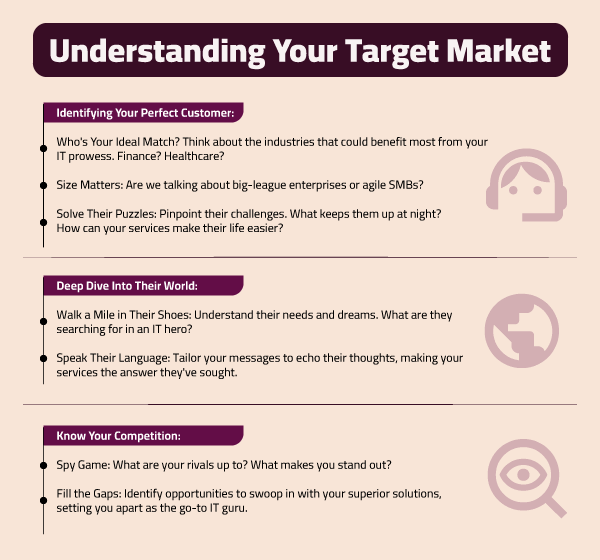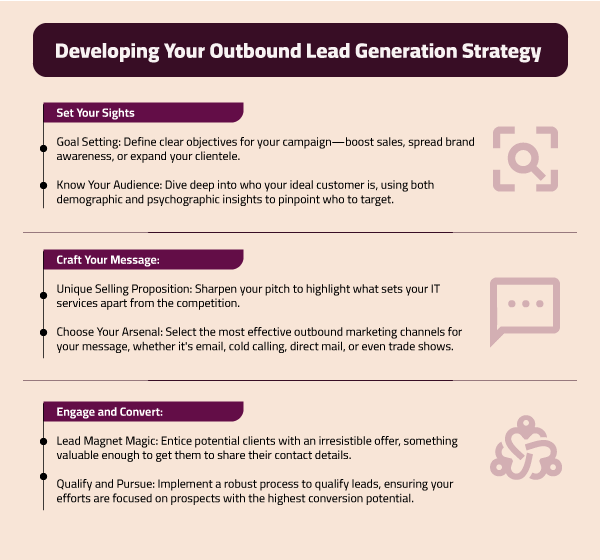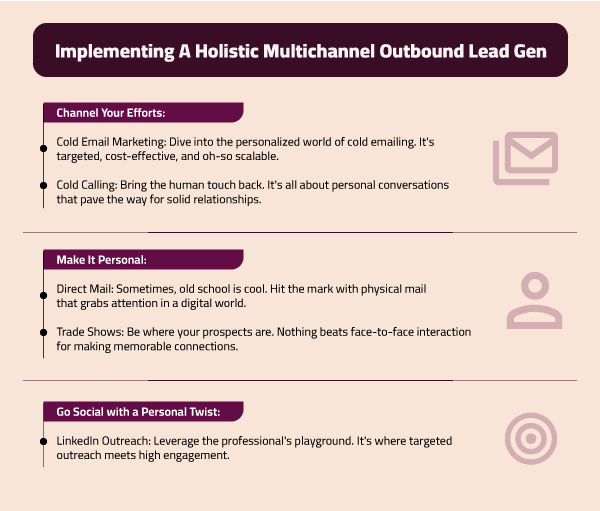
How to Generate Leads for IT Services: 5 Smart Tips
Lead generation is the backbone of any successful IT service business. You can grow your customer base and increase revenue by attracting potential customers and capturing their information.
According to a study, companies with strong lead generation strategies generate 50% more sales-ready leads at a 33% lower cost per lead. That's a significant return on investment, right?
But why lead generation for IT services is so important specifically?
Well, information technology is in high demand, but the competition is also fierce. By implementing solid sales prospecting techniques for IT lead generation, you can stand out from your competitors and reach your target audience more effectively.
How to Generate Leads for Your IT Business?
To be more specific, your IT firm should consider outbound marketing as a way to reach a wider audience and increase your chances of generating leads.
Why?
You can showcase your services to a larger pool of potential customers, who may not have otherwise been aware of your offerings. Outbound marketing also allows you to build relationships with potential clients and establish your brand as a trusted solution provider in their industry.
Additionally, to create a comprehensive lead generation strategy, outbound marketing can complement inbound marketing efforts, such as SEO and content marketing. With the right approach, outbound marketing can deliver a high ROI if you are looking to grow your business.
Check out how to choose an ideal IT Lead Generation Service Provider.
In this guide, you'll discover 5 smart tips and tricks that you can use to generate leads for your IT services business. Let’s get started!
1. Understanding Your Target Market

Defining your target audience is crucial in generating leads for your IT services business. Here's how you can identify your ideal customer and understand their needs and pain points:
Identifying Your Perfect Customer
Start by thinking about who your services would best serve.
- What industries do they work in?
- What size are their businesses?
- What are their pain points and what solutions do they need?
By defining your ideal customer, you can develop your lead generation strategy per their specific needs and increase the chances of attracting high-quality IT business leads.
Understanding Their Needs and Challenges
Once you've identified your ideal customer, dive deeper into their requirements and challenges. This will help you gauge what they are looking for in an IT service provider.
By researching their demands, you can tailor your messaging to their specific requirements and position your IT services as the solution they need. This will increase the chances of attracting premium prospects that are more likely to convert into paying customers.
Researching Your Competitors:
Take a look at your competitors to see what they are offering and what makes them unique. This will give you an idea of what works for your competitors and what doesn't in your niche. In addition, it will provide you with a competitive edge to differentiate yourself from your competitors.
By knowing your competitors, you can identify opportunities to fill gaps in the market and position your IT services as a superior solution.
2. Developing Your Outbound Lead Generation Strategy

Building a successful outbound lead generation strategy requires careful planning and execution. Here are some tips to help you build a winning strategy:
- Defining Your Objectives: Clearly define what you want to achieve through your outbound lead generation strategy, such as increasing sales, building brand awareness, or expanding your customer base.
- Setting Your Target Market: Research your ideal customer profile, including demographic and psychographic information, to determine who you should target with your outbound lead generation efforts.
- Defining Your Ideal Customer Profile: Also look at your existing customer database. Prepare a list of decision-makers' job responsibilities, titles, industries, niches, and pain points.
- Describing Your Unique Value Proposition: Clearly articulate the unique value you offer to your target market and how it sets you apart from your competitors.
- Selecting the Right Outbound Marketing Channels: Determine which outbound marketing tactics are best suited for your target market and objectives, such as email marketing, cold calling, direct mail, or trade shows and events.
- Creating a Lead Magnet: Develop a compelling offer, such as a free guide or trial, to attract potential customers and incentivize them to provide their contact information.
Developing a Lead Qualification Process: Identify the criteria for a qualified lead, such as budget, decision-making authority, and timeline, to ensure that your outbound efforts are focused on the most promising leads. - Creating Engaging Content: Develop compelling content, such as emails, direct mail pieces, and scripts for cold calling, to engage and build relationships with your target market.
3. Implementing Holistic Multichannel Outbound Lead Gen Campaigns

Implementing holistic multichannel outbound lead generation campaigns is the next step in your lead generation journey. Here are some tools to get you started.
Cold Emailing
Email marketing, especially cold emailing, can be an effective tool in outbound marketing, as it allows you to reach potential customers directly and share information about your IT services. Here are some reasons:- Targeted: Cold emailing allows you to target specific individuals or companies that match your ideal customer profile. This makes it a highly targeted form of marketing, which can increase the chances of generating IT business leads.
- Cost-Effective: Cold emailing is a cost-effective marketing method, as it does not require a significant investment in advertising or other forms of marketing.
- Measurable: Cold emailing allows you to track and measure the success of your campaigns, which helps you optimize your efforts and improve your results over time.
- Scalable: Cold emailing can be easily scaled to reach a larger audience, making it a great choice for growing businesses.
However, response rates can vary greatly depending on the quality of your messaging, the relevance of your offer to the recipient, and other factors. Let’s check out how you can design the right email marketing strategy.
- Build Your Email List: Compile a list of relevant and interested prospects through research and lead magnets.
- Create a Compelling Subject Line: Write a subject line that captures the recipient's attention and makes them want to open the email.
- Personalize the Email: Use the recipient's name and address specific pain points or needs to make the email feel more personalized and relevant.
- Write Compelling Copy: Write a clear and concise email copy that highlights the benefits of your product or service and how it solves their problems.
- Include a Call-to-Action: Encourage the recipient to take a specific action, such as scheduling a demo or requesting more information, to move them further down the sales funnel.
- Test and Optimize: Test different elements of the email, such as subject lines and copy, to see what resonates with your target market and optimize your campaigns accordingly.
- Track and Analyze Results: Use metrics such as open rates, click-through rates, and conversion rates to track and analyze the success of your cold email campaigns.
Cold Calling
Cold calling can be a successful outbound strategy for IT services companies, as it allows for direct and personal interactions with potential customers. Here are some reasons why cold calling can be effective:- Personalized: Cold calling provides an opportunity to have a two-way conversation with potential customers and tailor your message to their specific needs and pain points. This personal touch can increase the chances of generating leads and building relationships.
- Qualify Leads: Cold calling can help you quickly determine whether a potential customer is a good fit for your IT services, allowing you to focus your efforts on the most promising leads.
- Build Relationships: Cold calling can be a great way to build relationships with potential customers, which can increase the likelihood of future business opportunities.
However, studies have shown that the average response rate for cold calling is around 2-5%, with the highest-performing campaigns achieving response rates as high as 10%.
You can increase your response rates and achieve better results by continuously monitoring and optimizing your campaigns. Let’s see how:
- Build Your Call List: Compile a list of relevant and interested prospects through research from various sources like Zoominfo, LinkedIn, Websites, etc.
- Prepare a Script: Write a script that outlines the key points you want to make and helps you stay on track during the call.
- Research Your Prospects: Research each prospect before making the call to understand their needs and pain points and to better tailor your pitch.
- Personalize the Call: Address the recipient by name and reference specific information about their company or industry to make the call feel more personalized.
- Start with a Strong Introduction: Begin the call with a strong and confident introduction that grabs the recipient's attention and establishes rapport.
- Make a Compelling Pitch: Clearly articulate the USPs of your product or service and how it solves their problems to make a compelling pitch.
- Overcome Objections: Anticipate and be prepared to overcome common objections, such as price or lack of time, to move the prospect further down the sales funnel.
- Appointment Setting: Ask for a discovery call or the next step in the process to close the deal and move the prospect towards becoming a customer.
- Track and Analyze Results: Use metrics such as call-to-appointment rate, appointment-to-sale rate, and conversion rate to track and analyze the success of your cold calling campaign.
Direct Mail Marketing
Why direct mail? Though it may not have significant ROI it has its own benefits like staying on the top of the mind of ideal customers.
It allows you to reach potential customers with a physical message and share information about your services. Here are some statistics that highlight the success of direct mail in outbound lead generation:
- Open Rates: The average open rate for direct mail is around 20-30%. This indicates that a significant portion of recipients is at least taking a look at the message and considering your offer.
- Response Rates: The average response rate for direct mail campaigns is around 3-5%, with the highest-performing campaigns achieving response rates as high as 10%. This shows that many recipients are taking action and expressing interest in your IT services.
- ROI: Direct mail has a higher ROI than other marketing forms, such as email and social media. A study found that the average ROI for direct mail campaigns is around 29%.
- Targeting: Direct mail allows you to target specific individuals or companies that match your ideal customer profile, which can increase the chances of generating leads and closing deals.
These statistics highlight the potential of direct mail as a successful tool in outbound lead generation for IT services companies.
By crafting compelling messaging and utilizing targeting and segmentation strategies, you can maximize the impact of your direct mail campaigns and generate leads for your business. Here are some tips
- Build Your Mailing List: Compile a list of relevant and interested prospects through research, and lead magnets.
- Choose the Right Format: Decide on the format of your direct mail piece, such as postcards, letters, or brochures, based on your target market and objectives.
- Develop Compelling Copy: Write clear and concise copy that highlights the benefits of your product or service and how it solves their problems.
- Incorporate Visual Elements: Include eye-catching visuals, such as images and graphics, to capture the recipient's attention and reinforce your message.
- Use a Compelling Offer: Offer a compelling incentive, such as a discount or free trial, to encourage the recipient to take action and respond to your direct mail piece.
- Personalize the Mailing: Personalize the direct mail piece with the recipient's name and address to increase relevance and engagement.
- Test and Optimize: Test different elements of the direct mail piece, such as format, copy, and offers, to see what resonates with your target market and optimize your campaign accordingly.
- Track and Analyze Results: Use metrics such as response rate, conversion rate, and cost per acquisition to track and analyze the success of your direct mail marketing campaign.
Trade Shows and Events
Attending networking events can be a valuable tool for IT services companies to generate leads through outbound marketing. Here's how you can make the most of these events:- Define Your Objectives: Define your objectives for attending the trade show or event, such as generating leads, building brand awareness, or networking.
- Choose the Right Event: Research and select trade shows and events that align with your target market and objectives.
- Develop a Booth or Display: Design a booth or display that effectively showcases your brand and product or service.
- Train Your Team: Train your team on effectively engaging with attendees and making a strong impression.
- Plan for Lead Generation: Develop a lead generation strategy, such as collecting contact information or scheduling follow-up appointments, to maximize the results of your attendance.
- Promote Your Attendance: Promote your attendance at the trade show or event through your website, social media, and email marketing to drive traffic to your booth.
- Engage with Attendees: Engage with attendees at the trade show or event, answering questions and demonstrating your product or service.
- Network with Industry Leaders: Take advantage of the opportunity to network with industry leaders and potential partners.
- Follow Up with Leads: Promptly follow up with any leads generated at the trade show or event to continue the conversation and move them further down the sales funnel.
- Evaluate Your Results: Evaluate the results of your attendance at the trade show or event, including the number of leads generated and overall ROI, to continually improve and optimize your strategy.
LinkedIn Direct Outreach
LinkedIn Direct Outreach can be a highly effective outbound lead generation strategy for IT services companies. Here are a few reasons why:
- Targeting: LinkedIn allows you to target specific individuals and companies based on factors such as job title, industry, location, and more. This allows you to reach individuals who are most likely to be interested in your IT services.
- Professional Environment: LinkedIn is a professional networking platform, making it an ideal place to connect with potential clients and engage in outbound lead-generation activities.
- High Engagement Rates: LinkedIn has high engagement rates, with users checking the platform regularly and responding to messages from connections. This can increase the chances of generating leads and building relationships through direct outreach.
- Personalized Messaging: LinkedIn allows you to tailor your messaging to the specific needs and pain points of potential clients, increasing the chances of generating leads and closing deals.
- Trust and Credibility: LinkedIn can help build trust and credibility with potential clients, as it allows you to showcase your experience and expertise in your field.
By utilizing LinkedIn Direct Outreach as part of your outbound lead generation strategy, you can reach potential clients, build relationships, and boost your IT services lead generation. Let’s check out how:
- Optimize Your Profile: Optimize your LinkedIn profile to make a strong first impression, including adding a professional headshot, writing a compelling summary, and highlighting your relevant experience and skills.
- Build Your Connections: Build your network of relevant connections by connecting with current and potential customers, partners, and influencers in your industry.
- Engage with Your Network: Regularly engage with your network by commenting on posts, sharing relevant content, and reaching out to connect with new prospects.
- Use LinkedIn Groups: Join relevant LinkedIn groups and participate in discussions to build relationships and establish yourself as an expert in your field.
- Create and Share Compelling Content: Create and share compelling content, such as articles, videos, and infographics, to educate and engage your network and position yourself as a thought leader.
- Utilize LinkedIn Ads: Utilize LinkedIn Ads to reach a wider audience and drive traffic to your website or landing page.
- Send Personalized Messages: Send personalized messages to potential customers, highlighting how your product or service solves their problems and offering to set up a call or meeting.
- Track and Analyze Results: Use metrics such as open rate, click-through rate, and conversion rate to track and analyze the success of your LinkedIn outbound marketing campaign.
- Continuously Optimize: Regularly review and analyze your results and make data-driven decisions to continually improve and optimize your LinkedIn outbound marketing strategy.
Conclusion
You've learned how you can grow your IT services leads. You've seen the benefits of implementing an effective outbound lead generation strategy, including increased visibility, improved targeting, and higher conversion rates.
As you reflect on this information, remember that lead generation is key to growing your IT services business and reaching new clients.
So take action and implement the smart lead generation tips and tricks discussed in this article to enhance your own outbound lead generation efforts. And if you're looking for an IT Lead generation service provider to help take your lead generation to the next level, be sure to contact Revnew.
Related Blog: 5 Data-driven Sales Prospecting Techniques for IT Lead Generation That Will Guarantee You Success!




